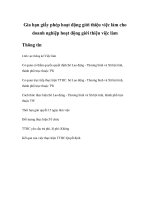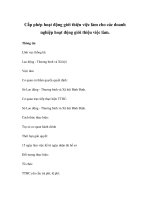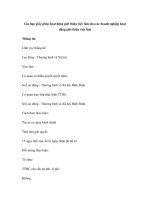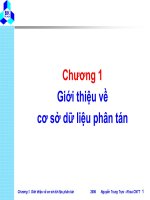giới thiệu về hệ điều hành
Bạn đang xem bản rút gọn của tài liệu. Xem và tải ngay bản đầy đủ của tài liệu tại đây (2.65 MB, 74 trang )
Chapter 1: Introduction
Operating System Concepts – 10h Edition
Silberschatz, Galvin and Gagne ©2018
ACKNOWLEDGEMENT
The contents of these slides have origin from Silberschatz, Galvin and Gagne, Operating
System Concepts – 10th Edition, © 2018 Wiley. The slides are authorized for personal use,
and for use in conjunction with a course for which Operating System Concepts is the
prescribed text. Instructors are free to modify the slides to their taste, as long as the
modified slides acknowledge the source and the fact that they have been modified. Paper
copies of the slides may be sold strictly at the price of reproduction, to students of courses
where the book is the prescribed text. Any use that differs from the above, and any for
profit sale of the slides (in any form) requires the consent of the copyright owners; contact
Avi Silberschatz () to obtain the copyright owners consent.
Chapter 1: Introduction
▪
▪
▪
▪
▪
▪
▪
▪
▪
▪
▪
What Operating Systems Do
Computer-System Organization
Computer-System Architecture
Operating-System Operations
Resource Management
Security and Protection
Virtualization
Distributed Systems
Kernel Data Structures
Computing Environments
Free/Libre and Open-Source Operating Systems
Operating System Concepts – 10th Edition
1.3
Silberschatz, Galvin and Gagne ©2018
Objectives
▪ Describe the general organization of a computer system and the role
of interrupts
▪ Describe the components in a modern, multiprocessor computer
system
▪ Illustrate the transition from user mode to kernel mode
▪ Discuss how operating systems are used in various computing
environments
▪ Provide examples of free and open-source operating systems
Operating System Concepts – 10th Edition
1.4
Silberschatz, Galvin and Gagne ©2018
What Does the Term Operating System Mean?
▪ An operating system is “……..”
▪ What about:
• Car
• Airplane
• Printer
• Washing Machine
• Toaster
• Compiler
• Etc.
Operating System Concepts – 10th Edition
1.5
Silberschatz, Galvin and Gagne ©2018
What is an Operating System?
▪ A program that acts as an intermediary between a user of a
computer and the computer hardware
▪ Operating system goals:
• Execute user programs and make solving user problems
easier
• Make the computer system convenient to use
• Use the computer hardware in an efficient manner
Operating System Concepts – 10th Edition
1.6
Silberschatz, Galvin and Gagne ©2018
Computer System Structure
▪ Computer system can be divided into four components:
• Hardware – provides basic computing resources
CPU, memory, I/O devices
• Operating system
Controls and coordinates use of hardware among various
applications and users
• Application programs – define the ways in which the system
resources are used to solve the computing problems of the users
Word processors, compilers, web browsers, database systems,
video games
• Users
People, machines, other computers
Operating System Concepts – 10th Edition
1.7
Silberschatz, Galvin and Gagne ©2018
Abstract View of Components of Computer
Operating System Concepts – 10th Edition
1.8
Silberschatz, Galvin and Gagne ©2018
What Operating Systems Do
▪ Depends on the point of view
▪ Users want convenience, ease of use and good performance
• Don’t care about resource utilization
▪ But shared computer such as mainframe or minicomputer must keep
all users happy
• Operating system is a resource allocator and control program
making efficient use of HW and managing execution of user
programs
▪ Users of dedicate systems such as workstations have dedicated
resources but frequently use shared resources from servers
▪ Mobile devices like smartphones and tables are resource poor,
optimized for usability and battery life
• Mobile user interfaces such as touch screens, voice recognition
▪ Some computers have little or no user interface, such as embedded
computers in devices and automobiles
• Run primarily without user intervention
Operating System Concepts – 10th Edition
1.9
Silberschatz, Galvin and Gagne ©2018
Defining Operating Systems
▪ Term OS covers many roles
• Because of myriad designs and uses of OSes
• Present in toasters through ships, spacecraft, game machines,
TVs and industrial control systems
• Born when fixed use computers for military became more
general purpose and needed resource management and
program control
Operating System Concepts – 10th Edition
1.10
Silberschatz, Galvin and Gagne ©2018
Operating System Definition
▪ No universally accepted definition
▪ “Everything a vendor ships when you order an operating system” is a
good approximation
• But varies wildly
▪ “The one program running at all times on the computer” is the kernel,
part of the operating system
▪ Everything else is either
• A system program (ships with the operating system, but not part of
the kernel) , or
• An application program, all programs not associated with the
operating system
▪ Today’s OSes for general purpose and mobile computing also include
middleware – a set of software frameworks that provide addition services
to application developers such as databases, multimedia, graphics
Operating System Concepts – 10th Edition
1.11
Silberschatz, Galvin and Gagne ©2018
Overview of Computer System Structure
Operating System Concepts – 10th Edition
1.12
Silberschatz, Galvin and Gagne ©2018
Computer System Organization
▪ Computer-system operation
• One or more CPUs, device controllers connect through common
bus providing access to shared memory
• Concurrent execution of CPUs and devices competing for memory
cycles
Operating System Concepts – 10th Edition
1.13
Silberschatz, Galvin and Gagne ©2018
Computer-System Operation
▪
▪
▪
▪
I/O devices and the CPU can execute concurrently
Each device controller is in charge of a particular device type
Each device controller has a local buffer
Each device controller type has an operating system device driver
to manage it
▪ CPU moves data from/to main memory to/from local buffers
▪ I/O is from the device to local buffer of controller
▪ Device controller informs CPU that it has finished its operation by
causing an interrupt
Operating System Concepts – 10th Edition
1.14
Silberschatz, Galvin and Gagne ©2018
Common Functions of Interrupts
▪ Interrupt transfers control to the interrupt service routine
generally, through the interrupt vector, which contains the
addresses of all the service routines
▪ Interrupt architecture must save the address of the interrupted
instruction
▪ A trap or exception is a software-generated interrupt caused
either by an error or a user request
▪ An operating system is interrupt driven
Operating System Concepts – 10th Edition
1.15
Silberschatz, Galvin and Gagne ©2018
Interrupt Timeline
Operating System Concepts – 10th Edition
1.16
Silberschatz, Galvin and Gagne ©2018
Interrupt Handling
▪ The operating system preserves the state of the CPU by
storing the registers and the program counter
▪ Determines which type of interrupt has occurred:
▪ Separate segments of code determine what action should
be taken for each type of interrupt
Operating System Concepts – 10th Edition
1.17
Silberschatz, Galvin and Gagne ©2018
Interrupt-drive I/O Cycle
Operating System Concepts – 10th Edition
1.18
Silberschatz, Galvin and Gagne ©2018
I/O Structure
▪ Two methods for handling I/O
• After I/O starts, control returns to user program only
upon I/O completion
• After I/O starts, control returns to user program without
waiting for I/O completion
Operating System Concepts – 10th Edition
1.19
Silberschatz, Galvin and Gagne ©2018
I/O Structure (Cont.)
▪ After I/O starts, control returns to user program only upon I/O
completion
• Wait instruction idles the CPU until the next interrupt
• Wait loop (contention for memory access)
• At most one I/O request is outstanding at a time, no
simultaneous I/O processing
▪ After I/O starts, control returns to user program without waiting for
I/O completion
• System call – request to the OS to allow user to wait for I/O
completion
• Device-status table contains entry for each I/O device
indicating its type, address, and state
• OS indexes into I/O device table to determine device status
and to modify table entry to include interrupt
Operating System Concepts – 10th Edition
1.20
Silberschatz, Galvin and Gagne ©2018
Storage Structure
Operating System Concepts – 10th Edition
1.22
Silberschatz, Galvin and Gagne ©2018
Storage Structure
▪ Main memory – only large storage media that the CPU can
access directly
• Random access
• Typically volatile
• Typically random-access memory in the form of Dynamic
Random-access Memory (DRAM)
▪ Secondary storage – extension of main memory that provides
large nonvolatile storage capacity
Operating System Concepts – 10th Edition
1.23
Silberschatz, Galvin and Gagne ©2018
Storage Structure (Cont.)
▪ Hard Disk Drives (HDD) – rigid metal or glass platters covered
with magnetic recording material
• Disk surface is logically divided into tracks, which are subdivided
into sectors
• The disk controller determines the logical interaction between
the device and the computer
▪ Non-volatile memory (NVM) devices– faster than hard disks,
nonvolatile
• Various technologies
• Becoming more popular as capacity and performance increases,
price drops
Operating System Concepts – 10th Edition
1.24
Silberschatz, Galvin and Gagne ©2018
Storage Definitions and Notation Review
The basic unit of computer storage is the bit . A bit can contain one of two
values, 0 and 1. All other storage in a computer is based on collections of bits.
Given enough bits, it is amazing how many things a computer can represent:
numbers, letters, images, movies, sounds, documents, and programs, to name
a few. A byte is 8 bits, and on most computers it is the smallest convenient
chunk of storage. For example, most computers don’t have an instruction to
move a bit but do have one to move a byte. A less common term is word,
which is a given computer architecture’s native unit of data. A word is made
up of one or more bytes. For example, a computer that has 64-bit registers and
64-bit memory addressing typically has 64-bit (8-byte) words. A computer
executes many operations in its native word size rather than a byte at a time.
Computer storage, along with most computer throughput, is generally
measured and manipulated in bytes and collections of bytes. A kilobyte , or
KB , is 1,024 bytes; a megabyte , or MB , is 1,0242 bytes; a gigabyte , or GB , is
1,0243 bytes; a terabyte , or TB , is 1,0244 bytes; and a petabyte , or PB , is 1,0245
bytes. Computer manufacturers often round off these numbers and say that
a megabyte is 1 million bytes and a gigabyte is 1 billion bytes. Networking
measurements are an exception to this general rule; they are given in bits
(because networks move data a bit at a time).
Operating System Concepts – 10th Edition
1.25
Silberschatz, Galvin and Gagne ©2018
Storage Hierarchy
▪ Storage systems organized in hierarchy
• Speed
• Cost
• Volatility
▪ Caching – copying information into faster storage system; main
memory can be viewed as a cache for secondary storage
▪ Device Driver for each device controller to manage I/O
• Provides uniform interface between controller and kernel
Operating System Concepts – 10th Edition
1.26
Silberschatz, Galvin and Gagne ©2018









